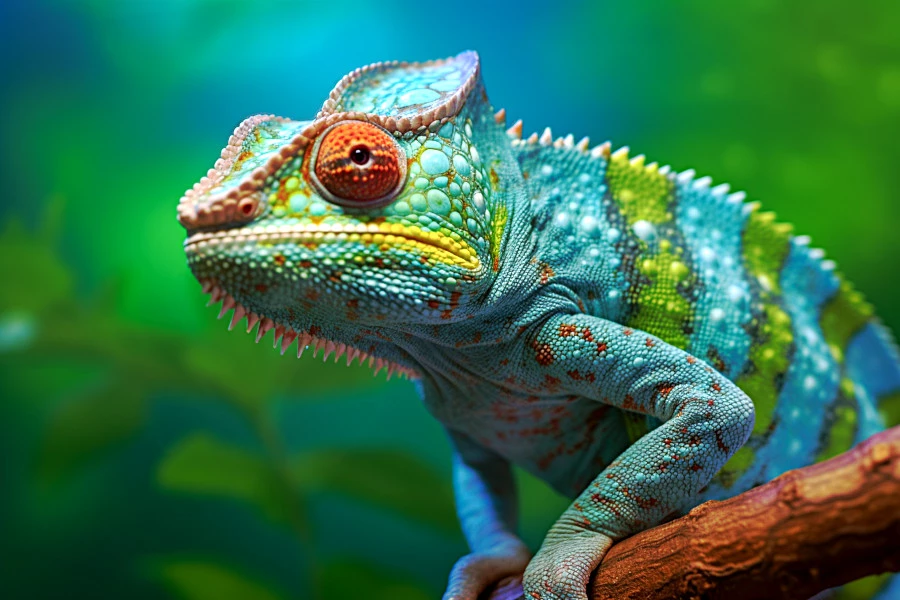Introducing combination skin – a tale of two halves. With its dry patches and oily shine, it can feel like you’re dealing with two completely different skin types.
This guide will help you better understand, care for, and embrace your unique combination skin. As we navigate the intriguing landscape of this skin type, you’ll pick up valuable insights and practical tips to keep your skin in balance and radiant.
Not sure about your skin type? That’s OK – we’ve got you covered: How to Find Your Skin Type and Get Glowing, Radiant Skin!
Here are the main topics we’ll be talking about:
Understanding Combination Skin
Defining combination skin is like describing a versatile artist; it’s a multifaceted phenomenon that displays more than one skin type on a single canvas—your face.

The fascinating thing about combination skin is its chameleon-like quality—shifting between its dry and oily facets as the seasons roll by. This skin type’s intriguing dual nature warrants a personalized skincare routine that addresses both the slick, oil-slicked areas and the parched, arid zones.
Let’s get into some of the most important topics, including:
- What is Combination Skin?
- The Main Characteristics of Combination Skin
- How to Identify Combination Skin
- Combination Skin vs Normal Skin
What is Combination Skin?
Combination skin is – as the name suggests – a combination of two of the main skin types, featuring both dry and oily areas. Typically, the forehead, nose, and chin – collectively known as the T-zone – are oily, while the cheeks and the area around the eyes and mouth are dry. The oily sections have large pores and may have pimples or blackheads, while the dry sections may appear dull and have smaller pores.
The Main Characteristics of Combination Skin
Combination skin is quite the chameleon, showing different characteristics in different zones. You might notice shiny skin and enlarged pores in your T-zone, a characteristic of oily skin, while your cheeks might be drier, maybe even flaky or rough, akin to dry skin. These disparate symptoms present in the same complexion make combination skin a unique, if sometimes perplexing, skin type.
How to Identify Combination Skin
To identify combination skin, take a closer look at your face after you’ve cleansed it. Wait for about an hour, resisting the urge to apply any products. If your T-zone becomes shiny while your cheeks remain matte or feel tight and dry, you likely have combination skin.
In the next sections, we’ll uncover the factors that contribute to combination skin, the challenges and perks of having it at different life stages, and the key to keeping this versatile skin type happy and healthy.
Combination Skin vs Normal Skin
‘Normal’ skin is somewhat of a misnomer in the skincare world. What we refer to as normal skin is essentially a well-balanced skin type – neither excessively oily nor overly dry. This skin type is characterized by a smooth texture, minimal pores, no severe sensitivities, and an even, clear complexion.
Read more: Normal Skin: Radiant Skincare Ultimate Guide
So, while normal skin is evenly balanced and requires less personalized care, combination skin calls for a more targeted approach. Your skincare regimen should address the unique needs of both dry and oily zones to maintain the overall health and appearance of your skin.
It’s like juggling two skin types at once, but with the right care, you can keep all balls in the air, maintaining your skin’s radiant glow.
What Causes Combination Skin?
The roots of combination skin predominantly lie in your genetic blueprint, much like its kin—dry skin, oily skin, or sensitive skin. However, don’t underestimate the plot twists life throws in.

Hormonal rollercoasters and shifting environmental scenes can also be influential cast members in the combination skin saga, particularly if you also have sensitive skin. Not to mention the potential impact of skincare routines gone awry—using the wrong products or methods can turn your skin’s balance upside down, nudging it towards the combination category.
Let’s take a closer look at the common causes:
Genetic Factors
Much like your eye color, your skin type is largely determined by your genes. If your parents have combination skin, there’s a good chance you will, too. It’s all in the DNA!
Lifestyle and Environmental Factors
Your skin reacts to what you eat, what you drink, and the environment around you. Spicy foods, alcohol, and caffeine can stimulate oil production, making your T-zone oilier. On the other hand, harsh weather conditions, air conditioning, and heating can dry out the skin on your cheeks.
Combination Skin Through Different Life Stages
Combination skin is a skin condition that can manifest at any life stage, but its incidence peaks during puberty and pregnancy due to a surge in hormonal activity which leads to increased oil production. As we journey through life, especially into our golden years, the oil-producing capability of our skin dwindles, causing your skin to tilt towards dryness.

It’s paramount to fine-tune your skincare regimen as you navigate through different stages of life, addressing the ever-changing demands of combination skin. Let’s go through some of these stages and talk about what might be happening with your skin:
Teenage Years
Teenage years are a time of hormonal change, and this can bring about an increase in oil production. For those with combination skin, this means the T-zone might become even oilier, while the cheeks remain dry.
Adulthood
In your adult years, you might find your skin type settles down a bit. However, stress, diet, and environmental factors can still cause fluctuations in the balance between the dry and oily areas of your skin.
Your Golden Years
As you age you’ll develop mature skin, which naturally becomes drier. The oil-producing glands are not as active as they used to be, meaning your T-zone might not be as oily, and your cheeks might become even drier.
Read more: Mature Skin: Radiant Skincare Ultimate Guide
In the next sections, we’ll discuss how to care for your skin and manage skin issues that can arise. We’ll provide valuable tips on choosing products, a recommended skincare routine, and when to seek professional advice.
How to Care for Combination Skin
Tending to combination skin calls for a skincare protocol that takes both the oily and dry regions into account. Remember that each individual’s skin is a canvas of their unique biology, meaning it may take a bit of experimentation to discover the perfect combination of skincare products that deliver results for your skin.

Let’s have a quick look at some tips to help you care for your skin if it’s a combination of dry and oily:
- Cleansing
- Toning
- Moisturizing
- Exfoliating
- Sun Protection
- Ingredients to Look For and to Avoid
- Recommended Daily Skincare Routine
Cleansing
Cleansing is a crucial part of the skincare routine, particularly for combination skin. You should opt for gentle, balanced facial cleansers that can remove excess oil from the T-zone without drying out your cheeks.
Read more: Face Washing 101: Cleansing Your Face for Your Skin Type
Toning
Toners can help restore pH balance after cleansing, and can also provide additional cleaning for oily areas. Look for alcohol-free toners as alcohol can dry out the skin and stimulate more oil production.
Read more: Skin Toning & Tightening: 6 Healthy Habits for Radiant Skin
Moisturizing
Moisturizing is essential for combination skin. You may choose to use two different types of moisturizers – a light, oil-free moisturizer for your T-zone, and a more hydrating moisturizer for your cheeks.
Exfoliating
Exfoliating once a week can help unclog pores and remove dead skin cells. Be gentle, though, as over-exfoliating can stimulate oil production in the T-zone and irritate dry areas.
Sun Protection
Regardless of your skin type, protecting your skin from the sun’s harmful rays is a must. For combination skin, a lightweight, oil-free sunscreen is a good choice.
Ingredients to Look For and to Avoid
When it comes to combination skin, it’s all about balance!
Look for products with ingredients like hyaluronic acid that hydrate the skin without making it oily. And avoid harsh ingredients like alcohol and fragrances that can dry out the skin and stimulate oil production.
Read more: Skincare Ingredients: Complete A-Z Guide
Recommended Daily Skincare Routine
A personalized skincare routine is key to managing combination skin. Cleanse, tone, and moisturize morning and night (applying sunscreen during the day). And don’t forget to exfoliate once a week!
Read more: Building an Effective Personalized Skincare Routine
In the next sections, we’ll tackle the different skin issues you may encounter and provide tips for managing them.
Common Skin Conditions for Combination Skin
Just like any other skin type, combination skin has its unique set of challenges that need a dedicated plan of action. From those stubborn breakouts to skin sensitivity, you need to know how to handle them.

Let’s talk about some ways to manage skin conditions:
- Tackling Acne and Breakouts
- Calming Redness and Sensitivity
- Countering Dryness and Flaky Skin
- Home Remedies and Skin Treatments
- When to Consult a Dermatologist
Tackling Acne and Breakouts
Acne and breakouts are common in areas with more oil glands. The T-zone, which includes your forehead, nose, and chin, is usually the main culprit and in some cases, oily skin can develop into acne-prone skin. To combat this, look for non-comedogenic products. Salicylic acid and benzoyl peroxide can be effective ingredients in targeted spot treatments.
Calming Redness and Sensitivity
While your oily T-zone battles with acne, your cheeks might struggle with redness and sensitivity. The key here is to keep your skin calm and hydrated.
Look for soothing ingredients such as chamomile, aloe vera, or niacinamide in your skincare products. Avoid anything that makes your skin feel uncomfortable or irritated.
Read more: Toxin-Free Skincare: Clean Ingredients & Natural Products
Countering Dryness and Flaky Skin
Dry and flaky areas can be annoying. But with the right approach, you can keep flaky skin at bay.
Start with a gentle exfoliation once or twice a week to remove dead skin cells. Follow this with a hydrating serum or cream to lock in moisture.
Home Remedies and Skin Treatments
Home remedies like honey masks can provide soothing and antibacterial properties, ideal for managing breakouts and providing hydration. Another popular home remedy is using aloe vera gel, which has both hydrating and soothing properties.
Remember that while home remedies can support your skincare regimen, they can’t always replace the benefits of scientifically formulated skincare products.
When to Consult a Dermatologist
If your skin issues persist despite your best efforts, it might be time to seek professional help. Dermatologists can provide expert advice and may prescribe treatments not available over-the-counter. So, don’t hesitate to book that appointment if you’re worried about your skin.
Learn to Revel in Your Unique Skin Story
Combination skin, with its unique challenges, is just another facet of your individuality. Yes, it requires a bit more effort and understanding, but with the right care and products, you can reveal the beautiful balance that is your skin.

Remember, the journey to skin health is a marathon, not a sprint. Listen to your skin, treat it with kindness, and it will thank you. Stay radiant!
Frequently Asked Questions
Here are some of the most common questions I’m asked about combination skin, with short answers and links to other resources if you’d like to learn more:
- Why Do I Have Combination Skin?
- How Do I Know if I Have Combination Skin?
- What Does Combination Skin Look Like?
- Is Combination Skin Good or Bad?
- What Should I Avoid if I Have Combination Skin?
- Does Combination Skin Need Moisturizer?
- What Are Some Common Skin Problems for Combination Skin?
- What Skincare Products are Most Important for Combination Skin?
- Can Combination Skin Get Pimples and Blackheads?
- How Can I Get Rid of Combination Skin?
- Can Weather or Climate Affect My Combination Skin?
- How Often Should I Exfoliate Combination Skin?
- How Can I Manage Shine in the Oily Areas of My Combination Skin?
- Are There Any Particular Ingredients I Should Look for in Products for Combination Skin?
- Is it Normal for My Skin to Switch Between Dry, Oily, and Combination?
- Can Age Affect My Combination Skin?
- Can I Use Different Products on Different Areas of My Combination Skin?
- Can a Poor Diet Affect Combination Skin?
- Can Stress Affect My Combination Skin?
- How do Hormones Impact Combination Skin?
Keep in mind, your skin is as unique as your fingerprint. What brings about fabulous results for someone else might not work the same way for you. Always turn to a dermatologist for any doubts or concerns related to your skin health.
Why Do I Have Combination Skin?
Combination skin is often a result of genetic factors, meaning it is largely predetermined by your DNA. It can also be influenced by lifestyle choices, hormonal fluctuations, and environmental factors such as climate and pollution.
How Do I Know if I Have Combination Skin?
Combination skin usually presents with dry skin or normal skin in some areas, such as the cheeks, and oily skin in other areas, such as the forehead, nose, and chin (the so-called “T-zone”). If you notice that your skin exhibits both oiliness and dryness in different regions, you likely have combination skin.
What Does Combination Skin Look Like?
Combination skin may look shiny or greasy on the forehead, nose, and chin due to excess oil, but appear normal or even dry and flaky on the cheeks and around the eyes. You may also notice larger pores and more frequent breakouts in the oily areas of your skin.
Is Combination Skin Good or Bad?
There’s no such thing as ‘good’ or ‘bad’ skin types; each type has its unique characteristics and needs. With combination skin, the challenge lies in balancing the needs of both oily and dry areas. Once you find a routine that works, your skin can be just as healthy and beautiful as any other skin type.
What Should I Avoid if I Have Combination Skin?
If you have combination skin, avoid using products that are too harsh for dry areas or too moisturizing for oily areas. This might mean using different products on different parts of your face. Also, recognize which ingredients to avoid in skincare products, like ingredients that clog pores, irritate your skin, or exacerbate oiliness and dryness respectively.
Does Combination Skin Need Moisturizer?
Yes, even with its oily areas, combination skin benefits from moisturization. The trick is to find a light, non-comedogenic moisturizer for the oily zones, and a richer one for dry areas if needed.
What Are Some Common Skin Problems for Combination Skin?
Combination skin can be prone to blackheads, acne, and shininess in the oily areas, while dry areas can experience flakiness, tightness, and even redness or irritation. Managing these simultaneous issues can be a challenge.
What Skincare Products are Most Important for Combination Skin?
A gentle, non-drying cleanser, a light non-comedogenic moisturizer, and a broad-spectrum sunscreen are the basics for combination skin. Depending on your individual needs, you may also want to incorporate a separate moisturizer for dry areas, a BHA exfoliant for oily areas, and targeted treatments for any specific concerns.
Can Combination Skin Get Pimples and Blackheads?
Yes, the oily regions of combination skin can be prone to breakouts, including pimples and blackheads, especially in the T-zone. This is because oil, dead skin cells, and impurities can clog the pores, leading to these issues.
How Can I Get Rid of Combination Skin?
You can’t really “get rid” of combination skin, as it’s largely determined by your genes. However, with the right skincare routine, you can manage its challenges and keep your skin looking and feeling its best.
Can Weather or Climate Affect My Combination Skin?
Absolutely, weather or climate can indeed affect combination skin. Dry climates can exacerbate the dry portions of your skin, while humid or hot climates can make the oily areas even oilier. It’s important to adjust your skincare routine based on the weather and your environment to keep your skin balanced.
How Often Should I Exfoliate Combination Skin?
Exfoliation should be a part of your skincare routine, but it should be done cautiously. For combination skin, it’s typically suggested to exfoliate twice a week. However, you might need to adjust this frequency based on how your skin responds. Remember to be gentle to avoid skin irritation.
How Can I Manage Shine in the Oily Areas of My Combination Skin?
Managing shine in the oily areas of combination skin can be done through a combination of using the right skincare products, particularly non-comedogenic products with mattifying properties. Regularly using blotting papers for oily skin can also help absorb excess oil without affecting the dryer areas of your skin.
Are There Any Particular Ingredients I Should Look for in Products for Combination Skin?
Yes, you should look for products that contain ingredients like hyaluronic acid, which is excellent for hydration, and salicylic acid, which can help control oil and breakouts. It’s also good to look for gentle, non-comedogenic products that won’t clog pores or cause irritation.
Is it Normal for My Skin to Switch Between Dry, Oily, and Combination?
Yes, it is normal for skin types to change due to factors such as weather, hormones, or even age. If you notice your skin changing, it’s important to adapt your skincare routine to fit your current skin needs.
Can Age Affect My Combination Skin?
Yes, age can definitely affect your combination skin. As we age and develop mature skin, our skin generally becomes drier, so you may notice the oily parts of your skin becoming less oily, and the dry parts becoming drier. It’s crucial to regularly assess your skin and adjust your skincare routine as necessary.
Can I Use Different Products on Different Areas of My Combination Skin?
Absolutely! It’s actually recommended to use different products to cater to the different needs of your combination skin. You might want to use oil-free products on the oily parts of your skin and hydrating products on the dry areas.
Can a Poor Diet Affect Combination Skin?
Yes, a poor diet can negatively impact your skin. Foods high in sugar, for instance, can lead to increased oil production, while not drinking enough water can lead to dryness. Maintaining a balanced diet rich in fruits, vegetables, lean proteins, and plenty of water can help your skin look and feel its best.
Can Stress Affect My Combination Skin?
Stress can have a significant impact on all skin types, including combination skin. It can cause your skin to produce more oil, which could lead to breakouts. Stress can also exacerbate skin conditions like eczema, which could affect the dry areas of your skin.
How do Hormones Impact Combination Skin?
Hormonal changes can lead to increased oil production, which can make the oily parts of combination skin even oilier. This is especially common during certain times in the menstrual cycle, pregnancy, or with certain medical conditions. If you notice significant changes in your skin due to hormonal fluctuations, it may be worth discussing with a dermatologist.